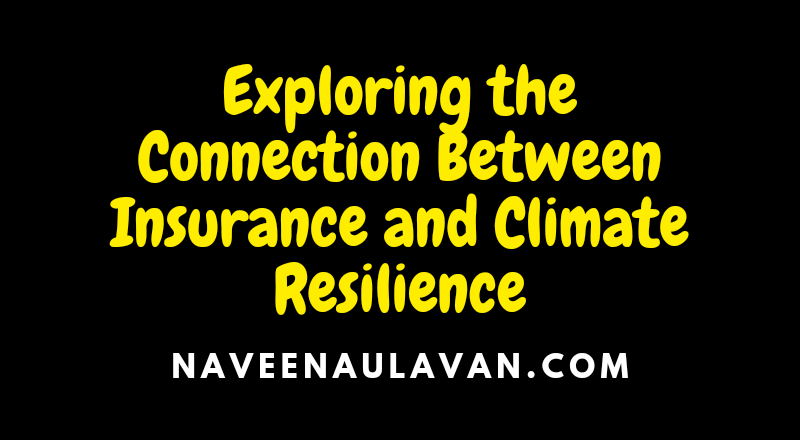Climate change poses a significant threat to our planet and its ecosystems. As global temperatures rise extreme weather events such as hurricanes floods wildfires and droughts are becoming more frequent and severe. These events have a profound impact on communities economies and the overall well-being of individuals. In this context insurance plays a critical role in helping individuals and businesses recover from climate-related disasters. However insurance companies themselves are also vulnerable to the increasing risks associated with climate change. This article aims to explore the connection between insurance and climate resilience and examine the challenges and opportunities that arise in this complex relationship.
The Role of Insurance in Climate Resilience
Insurance is a crucial component of climate resilience providing financial protection to individuals businesses and governments against the losses caused by climate-related events. It helps to spread the risk of these events across a wider pool of participants thereby reducing the impact of individual losses. Insurance policies may cover property damage loss of income and liability arising from climate-related disasters.
Insurance companies enable communities to recover quicker and more effectively after a climate-related event. They provide the necessary funds to repair or rebuild damaged infrastructure homes and businesses. This helps to stabilize the local economy and supports the overall recovery process. Insurance also encourages individuals and businesses to invest in climate resilience measures by offering incentives and discounts for adopting environmentally sustainable practices.
Moreover insurance can play a preventive role in climate resilience by promoting risk reduction and mitigation efforts. By assessing the risks associated with climate change insurance companies can incentivize policyholders to take proactive measures to reduce their vulnerability. For example insurance companies can offer lower premiums to homeowners who install flood-resistant measures or businesses that implement energy-efficient practices and utilize renewable energy sources.
The Challenges Facing Insurance in Climate Resilience
While insurance plays a critical role in climate resilience it faces several challenges associated with the increasing risks and uncertainties brought about by climate change. These challenges include the following:
Inaccurate Risk Assessment
Climate change introduces new and unpredictable risks that are not fully captured in traditional risk assessment models. Insurance companies rely on historical data to assess risks and set premiums. However as climate change accelerates historical data may become less relevant in predicting future risks. This can result in inaccurate risk assessment leading to either overpricing or underpricing of policies.
Inadequate Coverage
The increasing severity and frequency of climate-related events can strain insurance coverage particularly in high-risk areas. Insurance policies may have coverage limitations or exclusions for certain climate-related perils. As extreme weather events become more common individuals and businesses may find it challenging to obtain comprehensive coverage that adequately protects them against the full range of climate risks they face.
Adverse Selection and Moral Hazard
The concept of adverse selection refers to the tendency for higher-risk individuals or properties to seek insurance coverage more actively while lower-risk ones are less likely to purchase insurance. This can lead to an imbalance in the insurance pool resulting in higher premiums for those who choose to purchase insurance and potentially limiting coverage availability for those in need. Moral hazard occurs when insured individuals or businesses take on more risk because they believe insurance will cover any losses. This behavior can undermine risk reduction and mitigation efforts.
Opportunities for Insurance in Climate Resilience
Despite the challenges they face insurance companies have opportunities to enhance climate resilience and contribute to a sustainable future. These opportunities include:
Improved Risk Modeling
Insurance companies can invest in research and development to improve risk modeling capabilities. By incorporating climate change data and utilizing advanced analytical techniques insurers can better assess the potential impacts of climate-related events and price policies more accurately. This will help ensure that insurance coverage is fair accessible and economically sustainable for both policyholders and insurers.
Innovative Insurance Products
Insurers can develop innovative insurance products that address the specific needs and vulnerabilities resulting from climate change. For example parametric insurance policies that provide predefined payouts based on predetermined triggers (such as wind speed rainfall or temperature) can provide rapid and efficient financial assistance to policyholders in the aftermath of a climate-related event. Index-based insurance which uses an index linked to a particular climate variable can also be utilized to protect farmers against crop loss due to extreme weather conditions.
Collaboration with Other Stakeholders
Insurance companies can collaborate with government agencies NGOs and other stakeholders to develop comprehensive climate resilience strategies. By working together they can pool knowledge resources and expertise to address the complex challenges posed by climate change. Such collaborations can also help identify and prioritize the most vulnerable communities and develop tailored insurance solutions that meet their specific needs.
Integration of Climate Data
Insurance companies can integrate climate data into their risk assessment models and underwriting processes. By leveraging climate projections insurers can estimate future risks more accurately identify vulnerable areas and tailor insurance products accordingly. This integration can also help insurers promote risk reduction and mitigation efforts by encouraging policyholders to take proactive measures to minimize their susceptibility to climate-related losses.
Conclusion
Insurance plays a crucial role in climate resilience by providing financial protection against the losses caused by climate-related events. However insurance companies themselves are not immune to the risks associated with climate change. Inaccurate risk assessment inadequate coverage adverse selection and moral hazard pose significant challenges to the insurance industry. Nevertheless there are opportunities for insurers to enhance climate resilience through improved risk modeling innovative insurance products collaboration with stakeholders and the integration of climate data. By embracing these opportunities and addressing the challenges head-on insurance companies can help build a more climate-resilient and sustainable future.
